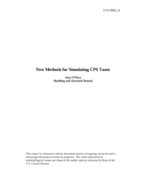
An official website of the United States government
Here’s how you know
Official websites use .gov
A .gov website belongs to an official government organization in the United States.
Secure .gov websites use HTTPS
A lock (
) or https:// means you’ve safely connected to the .gov website. Share sensitive information only on official, secure websites.
-
//
- Census.gov /
- Census Working Papers /
- New Methods for Simulating CPS Taxes
New Methods for Simulating CPS Taxes
New Methods for Simulating CPS Taxes
Introduction
The Census Bureau produces federal, state and payroll tax estimates for the Current Population Survey Annual Social and Economic Supplement (CPS ASEC). These estimates are used when calculating the alternative income definitions used in the Income in the United States report series and the National Academy of Sciences (NAS) income definitions used in the Experimental Poverty Measures report series. Many of the variables are also released on the CPS public use file.
In the fall of 2004, the Census Bureau has implemented a new model to produce tax estimates. The new model closely follows the Internal Revenue Service (IRS) 1040 tax form and rules on filing unit formation and dependent assignment. More statutory adjustments and credits are simulated in the new model compared to the old tax model. The Census Bureau will continue to release the thirteen tax-related variables on the public use person file that have historically been included.
While the old tax model had been updated annually to account for changes in marginal tax rates, the underlying methodology had not been revised since the model’s inception in the early 1980s. The new model will be continuously updated to reflect annual changes in the tax code and will investigate the simulation and inclusion of more items on the individual tax return. The new model will also be used to develop tax estimates for the Survey of Income and Program Participation (SIPP).
The remainder of this paper provides an extensive explanation of the new tax model. The methods used to sort the data into filing units, identify exemptions from relationship codes, and calculate taxes are described. Note that filing units are constructed from person-level survey data; they are not equivalent to households as defined by the surveys. IRS rules are used to determine filing requirements and dependent status, which determine the number of exemptions a return may claim. After the new model is described, comparisons of the old, new and IRS data for tax year 2002 are presented.
Share
Some content on this site is available in several different electronic formats. Some of the files may require a plug-in or additional software to view.
 Yes
Yes
 No
NoComments or suggestions?


Top

